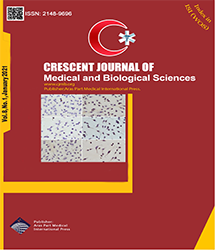
| Short Communication | |
| Comparison of the Results of Secundum Atrial Septal Defect Closure by Transcatheter and Open-Heart Surgery in the North West of Iran | |
| Akbar Molaei1, Shamsi Ghaffari2, Shahryar Anvari3, Mahya Rahimi Partovi4 | |
| 1Assistant Professor of Pediatric Cardiology, Medical Faculty, Tabriz University, Tabriz, Iran 2Associate Professor of Pediatric Cardiology, Medical Faculty, Tabriz University, Tabriz, Iran 3Assistant Professor of Cardiac Surgeon, Fellowship in Pediatric Cardiac Surgery Tabriz, Iran 4Pediatrician, Medical faculty, Tabriz University, Tabriz, Iran |
|
|
CJMB 2021; 8: 077-080 Viewed : 3148 times Downloaded : 2337 times. Keywords : Secundum atrial septal defect, Transcatheter, Amplatzer, Open-heart surgery |
|
| Full Text(PDF) | Related Articles | |
| Abstract | |
Objectives: Atrial septal defect (ASD) is one of the congenital diseases of the heart, which causes large cases of ASD requiring therapeutic interventions. In the event of a large defect of the atrial wall of the heart, the amount of blood shunted from the left atrium is noticeable and the amount of pulmonary blood flow increases, which can be associated with several symptoms and complications such as respiratory distress, recurrent infections, pulmonary artery hypertension, and large cavities. The right side of the heart is accompanied with failure, thus this abnormality needs treatment. The closure of secondum ASD as one of the congenital heart diseases can be conducted by transcatheter or open-heart surgery. Given the above-mentioned explanations, the present study was conducted to compare the two above-mentioned methods. Materials and Methods: In general, 60 patients treated with open-heart surgery (n=30) and transcatheter (n=30) were evaluated in this study. The two groups were compared in terms of success rate, hospitalization time, hospitalization costs, and complications such as infection, bleeding, arrhythmia, cardiac block, endocarditis, and the need for post-operative re-intervention. Results: Both groups were effectively treated with either of these two methods. The mean age of surgical patients was significantly (P=0.003) lower than those treated with transcatheter. Although the group treated with open-heart surgery had higher amounts of bleeding, arrhythmia, infection, heart block, hospitalization costs, and re-intervention, these differences were not statistically significant. During the study, none of the patients had endocarditis and none died as well. Finally, patients treated with transcatheter had a mean (standard deviation) duration of the hospitalization of 4.3 (±1.39) days, which was significantly lower (P<0.001) than the surgical method 11.1 (±4.6). Conclusions: Both trans-catheterization and open-heart surgery treatments are effective in treating patients with secondary ASD although the use of the transcatheter method is less risky and more cost-effective due to the findings in comparison with the open-heart surgery method. However, care should be taken in choosing the patient for this therapeutic intervention. In addition, patients treated with trans-catheterization had a shorter duration of hospitalization, which could be important in terms of family relocation to other family members and the system of treatment. Eventually, due to the high rate of bleeding from patients of young age in both groups, preclinical tests should be performed before the surgery in this age group in order to improve therapeutic techniques. |
Cite By, Google Scholar
Google Scholar
PubMed
Online Submission System
 CJMB ENDNOTE ® Style
CJMB ENDNOTE ® Style
 Tutorials
Tutorials
 Publication Charge
Medical and Biological Research Center
About Journal
Publication Charge
Medical and Biological Research Center
About Journal
Aras Part Medical International Press Editor-in-Chief
Arash Khaki
Deputy Editor
Zafer Akan


















